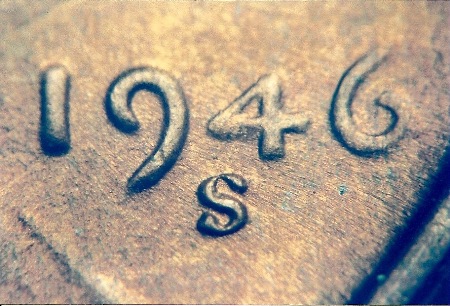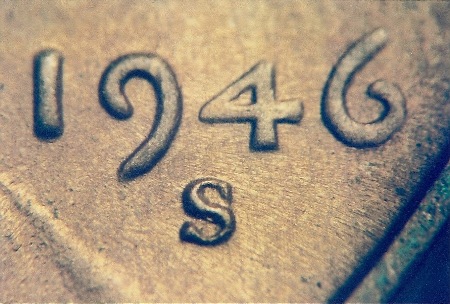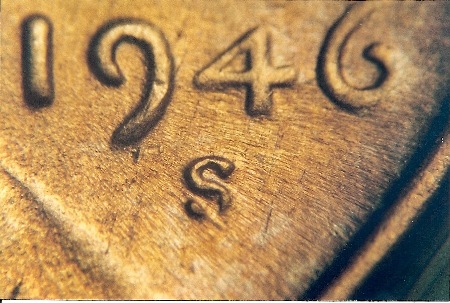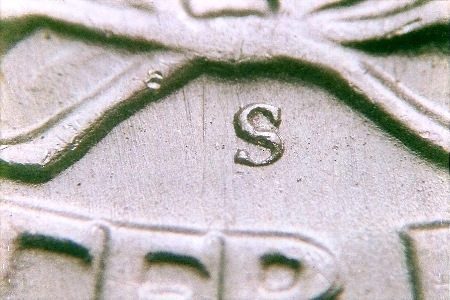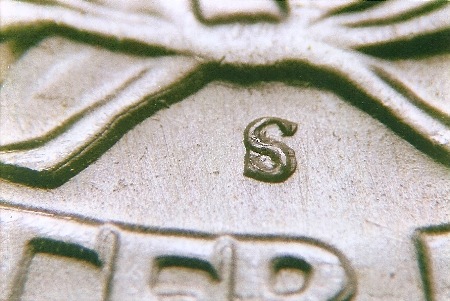


 |
 |
 |
 |
 |
 |
 |
 |
 |
 |
 |
 |
 |
 |
 |
 |
 |
 |
 |
 |
 |
 |
 |
 |
Another die variety has come onto the scene recently. Like the Repunched Mint Mark (RPM) varieties, the Over Mint Mark (OMM) varieties, and the Dual Mint Mark (DMM) varieties, it is the result of the mint mark being hand-punched into the working dies. The culprit so far has been the S mint mark. Inverted Mint Mark (IMM) varieties resulted when a mint mark was punched into a working die in an inverted or “upside down” position from the intended position of the mint mark. For some mint marks it was fairly easy to tell in the mint mark punch was in a proper orientation. These would include the D mint mark, the C mint mark, the CC mint mark, and the P mint mark. Examples of inverted D mint marks are known, but in all cases they were repunched with a D in the proper orientation creating D over Inverted D RPM varieties. Some examples of these can be found on the RPM and OMM Varieties page of this website. The main culprit so far for the Inverted Mint Mark variety has been the S mint mark. Over the years the Mint has used a number of different styles of S mint mark on the various denominations of U.S. coins. It would seem at first glance that there shouldn’t be any difference between an S and an inverted S, but that isn’t the case. The styles of S mint mark were not designed with symmetry in mind. There are distinct differences between the top of the S mint mark and the bottom of the S mint mark on most styles of S that the Mint used. As a result, if any of these S mint mark styles were punched into the working die in an inverted (upside down) position, you should be able to see the difference. For some years, especially in the mid-1940’s, as many as three different style S mint marks were used on a given denomination in a single year. For example, the 1946-S Lincoln cents can be found with three different styles of mint mark. They are referred to as the “Ball Serif S” style, the “Sans Serif S” style, and the “Trumpet Tail S” style.
This is the "Ball Serif S" mint mark used on the 1946-S Lincoln cents. Note the rounded serif at the top of the mint mark and the flattened serif on the bottom of the mint mark.
This mint mark style seen on a 1946-S Lincoln cent has come to be known as the "Sans Serif S" mint mark. There is no serif at the top of the mint mark while the bottom end of the mint mark is flattened.
The "Trumpet Tailed S" mint mark, which can also be found on the 1946-S Lincoln cents, has a lower mint mark that resembles the front end of a trumpet and a normal serif at the top of the mint mark. While these different styles within the same year make for an interesting collection in and of themselves, you will notice that each of the S mint mark styles illustrated is not symmetrical. There are distinct differences between the top of the mint mark and the bottom of the mint mark, so if any of these were punched into the die in an inverted orientation, you should be able to see the difference and some collectors have been noticing. More and more examples of Inverted Mint Mark (IMM) varieties for S mint coins are being found as collectors become aware of their existence and start looking for them. We recently had the opportunity to photograph a specimen of an inverted mint mark variety for the Ball Serif Style S on the 1946-S Lincoln cents.
This again is the "Ball Serif S" mint mark punched in a normal orientation on a 1946-S Lincoln cent.
This is a 1946-S Lincoln cent with a "Ball Serif S" mint mark punched in the inverted position. Hopefully you can see the difference between the two. In looking through my own collection of Washington Quarter doubled dies for a book project I was surprised to find two different 1945-S quarters with reverse doubled dies on which one of them also has an inverted mint mark. Both of the 1945-S doubled die quarters have the Trumpet Tail S style of mint mark. On the doubled die listed as 1945-S 25¢ WDDR-002 it is in the normal orientation, but on the doubled die listed as 1945-S 25¢ WDDR-003 it is definitely inverted.
This "Trumpet Tailed S" which is punched in the normal orientation can be found on the reverse of a 1945-S Washington Quarter doubled die variety that we have listed as 1945-S 25¢ WDDR-002. Note the doubling on the left branch and on the upper right side of the R in QUARTER.
This inverted "Trumpet Tailed S" mint mark can be found on the 1945-S Washington Quarter doubled die reverse that we have listed as 1945-S 25¢ WDDR-003. The S mint mark also shows some mechanical doubling, but close inspection shows that it is clearly an inverted mint mark. Again note the nice doubling on the left branch. The key to success in finding Inverted Mint Mark varieties is knowing what the "normal" mint marks are supposed to look like for any given date and denomination. Once you know what "normal" looks like, you will have an easier time spotting the inverted mint marks.
If you have suspected Inverted Mint Mark varieties that you would like to have attributed, the following guidelines must be followed. 1. The
fee for attributions is $5 per coin. Return postage and insurance is
extra and must be included with any coins that are sent. The rule of
thumb for return postage is that whatever it costs you for postage and
insurance to send the coins to me, that’s the amount that should be
included for postage and insurance to return the coins to you. Do NOT
include any padded mailers or other mailing envelopes in your package.
All packaging supplies for the return of the coins are provided as part
of the attribution service. Payment can be made with cash, money
orders, or personal checks. | ||


